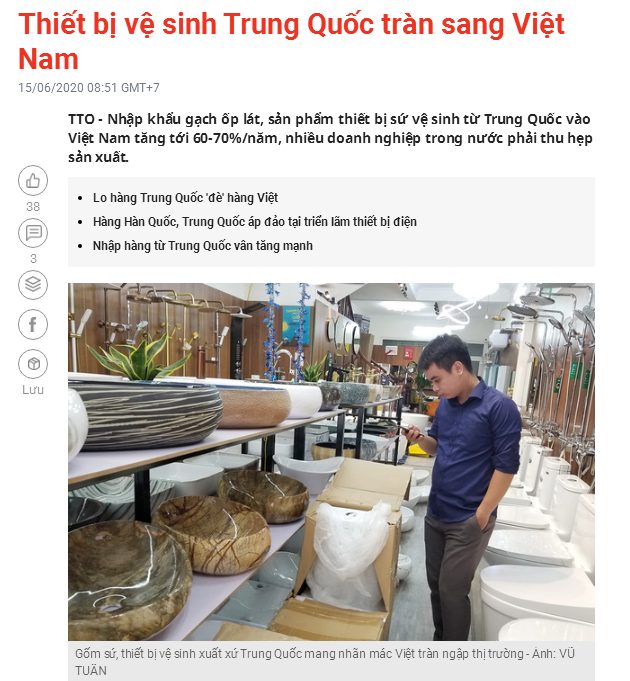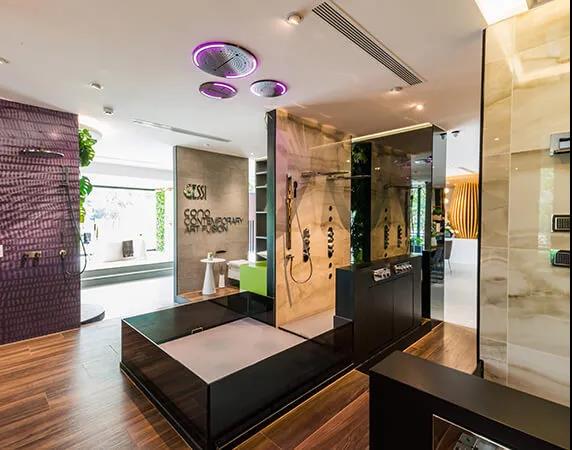베트남 언론 보도에 따르면, 베트남의 중국산 세라믹 타일 및 욕실 제품 수입액은 60-70% 매년. 많은 국내 기업이 생산 규모를 줄였습니다.. 베트남 당국은 건설부에 대책 마련을 지시했다.. 베트남은 같은 문제로 지난해 중국산 위생도기 수입을 강화했다., 하지만 효과는 확실하지 않은 것 같아요.
중국산 욕실이 빠르게 성장하고 있다.
일부 베트남 기업은 생산량을 줄였다. 20%
베트남 청년일보(Vietnam Youth Daily)의 최근 보도에 따르면, 신문사 기자가 하노이 가구점과 소매점을 방문했다., 호치민시 및 기타 도시에서 매장에서 중국에서 수입한 세라믹 타일과 욕실 제품을 대량으로 판매하는 것으로 나타났습니다.. 코레스트를 비롯한 브랜드, 계약, 열, 고베 , 축, 등.
이들 제품의 대부분은 한국과 일본의 공정기준에 따라 생산되었다고 주장하고 있습니다., 그러나 가격은 매우 저렴합니다, 중국산과 같은 “콤보” VND 미만으로 판매되는 욕실용품 4 백만 (RMB에 대해 1,200). INAX와 같은 다른 일반 브랜드와 유사한 제품의 가격은, 토토, 비글라세라, VND입니다 6-8 백만 (RMB에 대해 1800-2500).
베트남의 많은 욕실 브랜드는 현지 유통업체를 통해 중국에서 수입된 후 현지 등록 상표로 판매되는 것으로 알려졌습니다.. 예를 들어, 하노이 하동현의 한 세라믹 타일 및 위생용품 유통업체 직원은 매장에서 판매되는 모든 제품에는 회사의 상표가 있다고 말했다., 하지만 모든 제품은 중국에서 수입됩니다,” 중국 현지에서 생산된 제품이고 우리가 상표권 비용을 지불했다는 것을 이해하실 수 있습니다. “.
팜 반 베, 베트남 건설부 자재건설국장 , 지난 몇 년 동안, 베트남의 세라믹 타일과 중국의 위생 제품 수입은 60-70% 매년. 일부 현지 유통업체는 중국의 세라믹 타일 및 욕실 제품 수입이 지속적으로 증가하는 것은 미중 무역전쟁과 관련이 있다고 보고 있다.. 미국이 수입 세라믹 타일과 욕실 제품에 대한 중국의 관세를 인상했기 때문입니다. 250%, 중국 위생 기업은 제품을 수출하기 위해 동남아시아로 눈을 돌렸습니다..
중국산 타일과 위생용품 수입이 지속적으로 늘어나면서 일부 베트남 기업들은 감산에 나서야 했다.. Binh Duong 소재 Viglacera Company 관계자, 베트남은 중국 제품의 압력에 직면하여, 회사는 생산 능력을 거의 줄였습니다 20% ~에 2019. 이 상황에 대응하여, 베트남 당국은 이 문제를 건설부에 이의를 제기하고 있습니다., 현재 상황을 해결하기 위한 대책을 모으고 제안하고 있습니다..
처음은 아니다 “조임” 중국 위생용품 수입 비중
사실은, 베트남은 베트남 언론에 위협이 보도되기 전에 중국으로부터 위생용품을 수입하는 것에 대해 예방 조치를 취했습니다.. 10 월 2019, 베트남 관세청은 모든 성, 시의 세관에 위생용품 검사를 강화하도록 지시하는 문서를 발행했습니다., 특히 중국에서 유래한 것들, 전 부대에 순찰 강화를 요청했다., 국경 통과 시 건축자재 통제 및 감독. 문서에는 베트남 세관이 많은 기업으로부터 편지를 받았다고 명시되어 있다., 많은 수입 위생 제품을 반영합니다, 특히 중국에서 수입한 것들, 지역 베트남 기업의 생산 및 비즈니스 활동에 영향을 미쳤습니다..
베트남 세관의 통계에 따르면, 베트남은 지난해 중국에서 1억달러 상당의 세라믹 타일과 5200만달러 상당의 욕실용품을 수입했다. 2019. 하지만, 이 데이터에는 편차가있을 수 있습니다, 베트남 건축도자협회가 중국에서 수입한 타일제품의 가치가 2019 ~였다 200-$250 백만, 욕실 제품의 가치는 다음과 같습니다. $110-$120 백만.
위생 도기 회사에 대한 베트남의 매력은 여러 측면에서 나타납니다.. 지난 10년 동안, 베트남의 GDP가 증가했습니다 145.3%. 올해, Covid-19의 영향을받습니다, GDP 성장률은 느려질 것으로 예상됩니다 2.7%, 하지만 이는 여전히 세계 최초의 성장률이 될 가능성이 크다.. 게다가, 베트남의 도시화 과정도 빠른 속도로 진행되고 있다. 당국에 따르면, 인구가 증가함에 따라, 베트남은 구축해야합니다 100 매월 백만 평방 미터의 새로운 주택, 이는 욕실이나 기타 건축자재 회사에게는 흔치 않은 기회입니다..
현재, 다수의 국내 위생 기업이 베트남 시장에 진출했습니다., ~와 같은, 조무, 비행, 갈매기, CRW, 로타인터내셔널, Primy는 베트남 및 인근 국가에 사업을 운영하고 있습니다.. OEM으로 베트남 시장에 진출하는 기업도 많습니다.. 예를 들어, 에 보고된 바와 같이 “청년일보”, 이들 회사는 중국에서 제품을 생산하고 이를 베트남 유통업체에 판매하며, 베트남 유통업체는 제품에 라벨을 붙여 현지 시장에 판매합니다..
국제 브랜드의 투자가 증가함에 따라 경쟁이 심화됨
공동 시장 조사 보고서에 따르면, 베트남의 욕실 및 욕실 액세서리 시장은 다음과 같이 성장할 것으로 예상됩니다. $690 백만 단위로 2025. 현재, 베트남은 Toto를 포함하여 잘 알려진 많은 브랜드를 집중 시켰습니다., lixil, 게시와 카이사르, 이들 중 다수는 최근 몇 년 동안 베트남 시장에서 시장 점유율을 높이고 있습니다..
동남아 시장을 대상으로 한 TOTO 재무보고 부분, 베트남만 따로 언급됨. 회계상 2019, TOTO의 베트남 시장 매출은 VND에 달했습니다. 425.6 10억 (대략 RMB 1.3 10억), 증가 16% 전년 대비, 영업이익은 전년 대비 증가 25% VND야 655 10억 (대략 RMB 200 백만). 게다가, TOTO는 지난해 엔화 투자를 발표했다. 14.6 10억 (대략 RMB 970 백만) 베트남에 4번째 현지 공장 건립, 제품이 생산된 후 현지 판매를 촉진하는 제품입니다..
GESSI는 앞서 베트남 시장을 개척한 이탈리아 위생도기 회사입니다., 그리고 그 제품은 베트남에서 Vietceramics로 판매됩니다. ~ 안에 2018, 지안 루카 게시, Vietceramics' 개막식에 GESSI CEO와 Cecilia Piccioni 주베트남 이탈리아 대사 참석 1200 평방 미터의 새로운 전시장, 베트남 시장의 중요성을 보여주며, 베트남 시장의 중저가 위생용품 수요를 반영하여 지속적으로 성장하고 있습니다..
외국 브랜드 외에도, ASEAN 국가 최대의 세라믹 및 위생도기 제품 생산업체,, Viglacera 등 베트남 현지 브랜드 다수, Thien Thanh, Hao Canh, JSC Ceravi, 등. 시장점유율도 상당하다, 그리고 다른 아세안 국가들에 점차 침투했습니다. 이 지역 회사는 중국의 회사와 경쟁합니다, 일본, 이탈리아 등 베트남, 심지어 동남아까지 위생 산업 구조 형성. 지역주민들의 중저가 제품에 대한 수요가 지속적으로 증가하고 있는 것으로 판단됩니다., 저가형 제품은 계속 줄어들고, 고사양 제품으로 대체될 것. 해외 브랜드 간의 경쟁.





